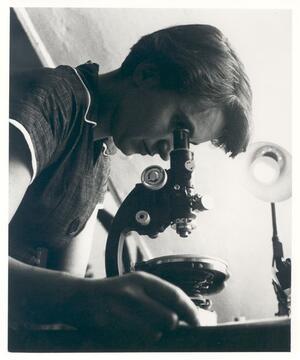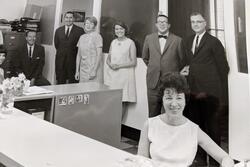Beyond the Double Helix: Rosalind Franklin Turns 100
In 1962, James Watson, Francis Crick, and Maurice Wilkins were awarded the Nobel Prize for identifying DNA’s double-helix structure. But, the award—and much of history thereafter—neglected to honor a young chemist whose critical research paved the way for this discovery.
Dr. Rosalind Franklin, a British Jewish scientist, is often remembered as a woman snubbed, but memorializing her this way is a disservice to her memory. In her brief life, Dr. Franklin helped lay the groundwork for modern structural virology, produced one of the most famous images of DNA, and even completed a PhD on pores in graphite. To celebrate what would have been her 100th birthday on July 25, 2020, here’s an overview of just some of the Jewish chemist’s non-double-helix accomplishments before her death from ovarian cancer at 37 in 1958:
She is most often remembered for her DNA research, but, in fact, she only spent two years studying DNA at King’s College London (KCL). In 1953, Dr. Franklin left KCL for Birkbeck College to work with crystallographer John Bernal. In the following five years before her death, she produced fruitful research on RNA viruses, resulting in 17 published papers. She notably used X-ray crystallography for much of her work, a method in which a crystalline structure impels an X-ray beam to diffract in many particular directions; the crystallographer then uses the diffracted beams’ angles and intensities to determine the mean positions of atoms in the crystal, creating its structure.
At Birkbeck, the tobacco mosaic virus (TMV) served as her model of choice. While TMV had already been crystallized and was a widely accepted RNA virus model, Dr. Franklin’s unprecedented research on the virus led to what is now considered basic virology. For example, she demonstrated that TMV’s single-strand protein materializes as a hollow spiral tube, wrapped in RNA. This assertion came as such a shock to the science world that her collaborator at the Agricultural Research Council no longer sent her viruses to study. Her methodology for the examination of TMV—X-ray diffraction—was precisely what she had used to find DNA’s double helix. Her research on TMV eventually helped garner another Nobel for someone else: Her Birkbeck teammate Aaron Klug won the Prize in 1982 for his findings on nucleic-acid protein crystal structures in part because of her studies.
Before studying DNA and RNA, Dr. Franklin examined coal. She got her start with coal research in 1942 working as an assistant research officer at the British Coal Utilisation Research Association. Her experiments on coal’s porosity and density helped her conclude that coal expelled substances in order of molecular size as temperature rose. This realization led her to accurately categorize coals and predict their optimal usage, which helped with wartime efforts and the production of gas masks.
After the war, Dr. Franklin was appointed as a researcher in Paris’s Laboratoire Central des Services Chimiques de l’État. There she met X-ray crystallographer Jacques Méring who implemented X-ray diffraction to amorphous substances, rather than regular crystals on which the method had typically been used. Méring taught her the very application she would go on to use for groundbreaking discoveries later in life. However, in Paris she applied this method to coal and other carbon-based substances with invaluable results. In addition to contributing to the disciplines of physics and chemistry regarding coal and carbon, she coined the terms “graphitizing” and “non-graphitizing” carbon, which refer to two types of carbon created by decomposing organic materials with heat.
Dr. Franklin’s contributions might be most widely taught in high school biology classrooms to students who learn about DNA’s unsung hero. While her contributions to understanding DNA can’t be overstated, her other, overlooked contributions continue to affect modern scientific understanding. The perilous virus of Dr. Franklin’s time was polio; we have our own baffling pathogen that scientists worldwide are clamoring to decipher.
Right now researchers are utilizing crystallization and X-ray diffraction to gather more data on SARS-CoV-2 and corresponding antibodies. With far more sophisticated technology than what was available to Dr. Franklin, today’s scientists employ the very same techniques that she used and made breakthrough discoveries with. Dr. Franklin is too often remembered as a brilliant woman who fell victim to sexism, which she was, but she also merits honor as a chemist by her own right.







